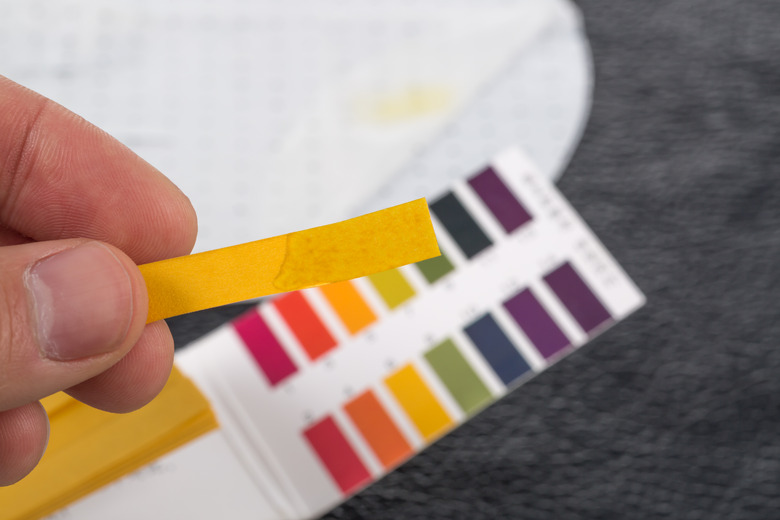How To Calculate Ka From Ph
Every acid has a characteristic dissociation constant (Ka), which is a measure of its ability to donate hydrogen ions in solution. In other words, Ka provides a way to gauge the strength of an acid. Larger values signify stronger acids. The pH (power of hydrogen) of a solution is a measure of the concentration of hydrogen ions and is also a measure of acidity, but it isn't the same as Ka. There's a relationship between the two, though, and you can calculate Ka for an acid if you know the concentration of acid and the pH of the solution.
Dissociation Constant Ka
Dissociation Constant Ka
A compound is acidic if it can donate hydrogen ions to an aqueous solution, which is equivalent to saying the compound is capable of creating hydronium ions (H30+). The general equation describing what happens to an acid (HA) in solution is:
HA + H20 <--> H30+ + A-, where A- is the conjugate base.
Some acids are strong and dissociate completely while others are weak and only partially dissociate. You can measure the strength of an acid by its dissociation constant Ka, which is a ratio formed by dividing the concentration of products by the concentration of reactants:
Ka = [H30+] [A-]/[HA]
All the reactions happen in water, so it it's usually deleted from the equation.
Deriving Ka from pH
Deriving Ka from pH
The pH of an aqueous acid solution is a measure of the concentration of free hydrogen (or hydronium) ions it contains: pH = -log [H+] or pH = -log [H30+]. The last equation can be rewritten:
[ H30+] = 10-pH
It you know the molar concentration of an acid solution and can measure its pH, the above equivalence allows you to calculate the relative concentration of acid to conjugate base and derive the dissociation constant Ka. To do this, it helps to set up a table that delineates the Initial concentrations of reactants and products, the Change in concentrations and the concentrations at Equilibrium. This is an ICE table. Rather than setting one up in a general way, it's more instructive to illustrate the procedure with a specific example.
Dissociation Constant for Acetic Acid
Dissociation Constant for Acetic Acid
Acetic acid, the acid that gives vinegar its sour taste, is a weak acid that dissociates into acetate and hydronium ions in solution.
CH3CO2H + H2O <--> CH3CO2− + H3O+
Typical household vinegar is a 0.9 M solution with a pH of 2.4. Using the data, it's possible to calculate the dissociation constant:
1. Set Up the ICE Table for Concentrations
Acetic Acid (CH3CO2)H) Hydronium Ions (H3O+) Acetate Ions ( CH3CO2-)
Initial 0.9 M 0 0
Change -x M +x M +x M
Equilibrium (0.9 – x) M x M x M
2. Write Ka as Ratio of Conjugate Base to Acid
The dissociation constant Ka is [H3O+] [CH3CO2-] / [CH3CO2)H].
3. Plug in Values from the Table
Ka = x2/(0.9 – x)
4. Note that x is Related to pH and Calculate Ka
As noted above, [H3O+] = 10-pH. Since x = [H3O+] and you know the pH of the solution, you can write x = 10-2.4. It is now possible to find a numerical value for Ka.
Ka = (10-2.4)2 /(0.9 – 10-2.4) = 1.8 x 10-5.
Cite This Article
MLA
Deziel, Chris. "How To Calculate Ka From Ph" sciencing.com, https://www.sciencing.com/how-to-calculate-ka-from-ph-13710445/. 23 March 2018.
APA
Deziel, Chris. (2018, March 23). How To Calculate Ka From Ph. sciencing.com. Retrieved from https://www.sciencing.com/how-to-calculate-ka-from-ph-13710445/
Chicago
Deziel, Chris. How To Calculate Ka From Ph last modified March 24, 2022. https://www.sciencing.com/how-to-calculate-ka-from-ph-13710445/
